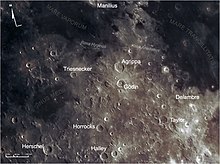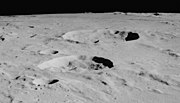
Mare Serenitatis is a lunar mare located to the east of Mare Imbrium on the Moon. Its diameter is 674 km (419 mi).

Copernicus is a lunar impact crater located in eastern Oceanus Procellarum. It was named after the astronomer Nicolaus Copernicus. It typifies craters that formed during the Copernican period in that it has a prominent ray system. It may have been created by debris from the breakup of the parent body of asteroid 495 Eulalia 800 million years ago.

Arzachel is a relatively young lunar impact crater located in the highlands in the south-central part of the visible Moon, close to the zero meridian. It lies to the south of the crater Alphonsus, and together with Ptolemaeus further north the three form a prominent line of craters to the east of Mare Nubium. The smaller Alpetragius lies to the northwest, and Thebit is to the southwest along the edge of the mare.

Fra Mauro is the worn remnant of a walled lunar plain. It is part of the surrounding Fra Mauro formation, being located to the northeast of Mare Cognitum and southeast of Mare Insularum. Attached to the southern rim are the co-joined craters Bonpland and Parry, which intrude into the formation forming inward-bulging walls. The crater is named after Italian geographer Fra Mauro.

Plinius is a prominent lunar impact crater on the border between Mare Serenitatis to the north and Mare Tranquilitatis to the south. Its diameter is 41 km. The crater is named after the Roman natural scientist and author Pliny the Elder. To the south-southeast of Plinius is the crater Ross, and to the northeast is Dawes. Just to the north is a system of rilles named the Rimae Plinius and touching it is the Brackett crater which is more than a crater diameter north. At the northwest edge of the rille is the Promontorium Archerusia, a cape off the western rim that encloses the Mare Serenitatis.
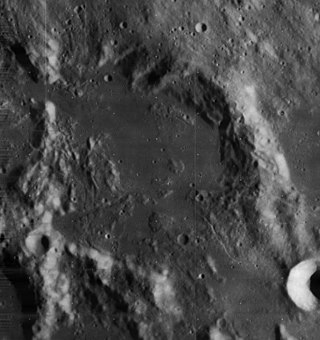
Murchison is a lunar impact crater on the north edge of the Sinus Medii. It was named in honour of the geologist Sir Roderick Murchison. It shares a section of rim with the crater Pallas. To the southeast on the mare is the circular crater Chladni, and to the northeast is Ukert. Farther to the east is the prominent Triesnecker. Murchison lies astride the lunar zenith line, i.e. the starting longitude of the selenographic coordinate system.

Petavius is a large lunar impact crater located to the southeast of the Mare Fecunditatis, near the southeastern lunar limb. Attached to the northwest rim is the smaller crater Wrottesley. To the southeast are Palitzsch, Vallis Palitzsch, and Hase. Farther to the north is the large crater Vendelinus. Petavius appears oblong when viewed from the Earth due to foreshortening. Petavius is Imbrian in age.

Burnham is a small crater located to the southeast of the crater Albategnius, in a relatively smooth area of the lunar surface. It was named after American astronomer Sherburne W. Burnham. To the southwest is Vogel.

Jansen is a lunar impact crater in the north part of the Mare Tranquillitatis. The diameter is 24 km. It was named after 17th century Dutch optician Zacharias Janssen. It is located to the east-southeast of the crater Plinius. The rim of Jansen is low and narrow, with a notch along the western edge. The interior is relatively level, which may indicate it has been covered by lava. To the south-southwest a small but prominent crater lies on the crater floor, halfway between the center and the rim.
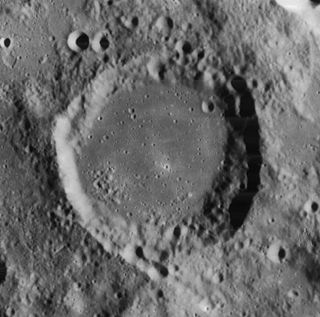
Abulfeda is a lunar impact crater located in the central highlands of the Moon. To the northeast is the crater Descartes, and to the south-southeast is Almanon. To the north is the crater Dollond. A chain of craters named the Catena Abulfeda runs between the southern rim of Abulfeda and the north rim of Almanon, then continues for a length of 210 kilometers across the Rupes Altai. The crater was named for 14th century Kurdish historian Ismael Abul-fida.

Julius Caesar is a lava-flooded lunar impact crater with a low, irregular, and heavily worn wall. Its diameter is 85 km. It was named after Roman statesman Julius Caesar. It is located to the west of Mare Tranquillitatis, and directly southeast of the crater Manilius on the Mare Vaporum. To the east is the rounded Sosigenes.

Ritter is a lunar impact crater located near the southwestern edge of Mare Tranquillitatis. Its diameter is 29.5 km. It was named after German geographer Carl Ritter and German astrophysicist August Ritter.

Stevinus is a lunar impact crater located in the southeast part of the Moon. To the southeast is the large crater Furnerius. Just to the northeast is Snellius and the Vallis Snellius crater valley. To the west-northwest lies Reichenbach. To the west-northwest of Stevinus is the tiny crater Stevinus A, a feature that possesses a small ray system and a displays a high albedo.
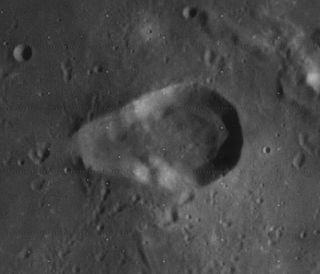
Torricelli is a lunar impact crater in the eastern part of the Sinus Asperitatis, to the south of the Mare Tranquillitatis. It was named after Italian physicist Evangelista Torricelli. The western rim of the crater is broken open and joined to a smaller crater to the west. The entire formation has a pear-shaped appearance. Torricelli lies in the northeastern part of a circular formation of rises in the lunar mare, possibly the remains of a crater formation buried by lava.

Godin is a lunar impact crater located just to the south of the crater Agrippa, on a rough upland region to the east of Sinus Medii. Its diameter is 34 km. The crater was named after 18th century French astronomer Louis Godin. The ruined crater Tempel lies to the northeast, on the east side of Agrippa. Due south is the flooded remains of Lade.

King is a prominent lunar impact crater that is located on the far side of the Moon, and can not be viewed directly from Earth. The crater was named after Arthur Scott King and Edward Skinner King in 1970. Prior to that, this crater was known as Crater 211. It forms a pair with Ibn Firnas, which is only slightly larger and is attached to the northeast rim of King. To the northwest is the crater Lobachevskiy, and Guyot is located an equal distance to the north-northwest.

Davy is a small lunar impact crater that is located on the eastern edge of the Mare Nubium. It was named after British physicist Humphry Davy. It overlies the lava-flooded remains of the satellite crater Davy Y to the east, a formation which contains a crater chain designated Catena Davy. To the southeast of Davy is the prominent crater Alphonsus.

Pasteur is a large lunar impact crater, approximately 233 kilometers in diameter, belonging to the category termed a walled plain. It was named after French chemist and microbiologist Louis Pasteur. It lies on the far side of the Moon as seen from the Earth, just beyond the eastern limb. The vicinity of this crater is occasionally brought into view from Earth due to librations, although not much detail can be seen.

Sklodowska (Skłodowska) is a large lunar impact crater that is located on the far side of the Moon. It lies just past the southeastern limb, and can sometimes be viewed from Earth under favorable conditions of libration and illumination. The crater is located to the northeast of the older walled plain Curie, and to the southwest of Pasteur, another walled plain.

Mandelʹshtam is the remains of a large crater on the Moon's far side named after Leonid Mandelstam. Nearly attached to the northeast outer rim is the crater Papaleksi. To the south lies the crater Vening Meinesz.
